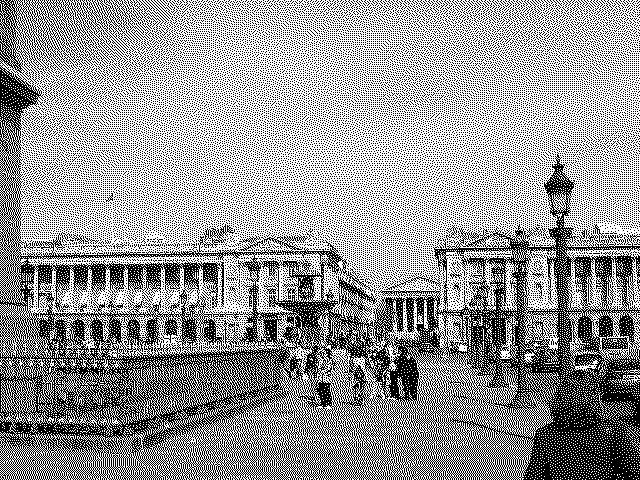Note: I've recently updated this assignment to break it up into three parts, instead of two. You've now got a little more time to work on this.
This is an individual assignment.
For this assignment, we will get fancier in our ability to process
images. We will now think of an image as a three-dimensional array of
pixels: the first dimension corresponds to the rows, the second to the
columns, and the third to the color bands. Note that this is a three part assignment. You need to write six methods, described below. Turn in any two of these methods on Friday, contained in a directory called image2. Turn in another two (with the original two, so four together) by Monday night in a directory called image3. Turn in the remaining two (with the other four, so a total of six) by Wednesday night in a directory called image4.
We will again use the EzImage class, which gives us some
of the basic tools that we need. For images, you can again use background1.jpg, background2.jpg, background3.jpg, amy.jpg, or dave.jpg, or obtain your own
image instead if you like: you can use your picture from the Carleton
directory or you can take a picture with a digital camera.
Your mission is to write new methods for PhotoLab. Start again from scratch with a new PhotoLab class. Here are the
methods that your PhotoLab class should have:
public EzImage crop(EzImage image, int rowStart, int rowStop,
int colStart, int colStop)
Crops your image. Extracts only those pixels from pixels
rowStart through rowStop and
colStart through colStop. If any of the
parameters are out of range for your image, return null. Otherwise, return the new image.
public EzImage dither(EzImage image)
Dithering is a technique used when you want to print a gray picture in
a place such as a newspaper where no shades are available. Instead,
you need to use individual pixels of black and white to simulate
shades of gray. The popular Floyd-Steinberg algorithm for dithering is
as follows:
- Loop over all pixels, running across one row at a time.
- For each pixel: if its value is larger than 128, set it to 255 (pure
white). Otherwise, set it to 0 (pure black). Record the "error", which
is the old value of this pixel minus the new one.
- This "error" represents how much blackness we have added to this
pixel. Distribute this blackness to adjacent pixels as
follows:
- Add 7/16 of the error to the pixel immediately to the right ("east").
- Add 3/16 of the error to the pixel immediately diagonally to the
bottom left ("southwest").
- Add 5/16 of the error to the pixel immediately below
("south").
- Add 1/16 of the error to the pixel immediately diagonally to the
bottom right ("souhteast").
- Any error to be distributed to pixels that are out of range
should be ignored.
Dithering should only be done on gray images, so convert the image to gray first inside your dither method. You can use the EzImage instance method copyToGrayScale() to convert an image to
gray.
In order for dithering to work, you must make your changes to the
same image that you are looping over. Dithering by reading one image
and making your changes on a copy will not work correctly, because the
"error" never gets a chance to accumulate. In other words, make sure
that you make a gray scale copy of the image first, and then do all
dithering work (looping, reading, writing, etc.) on the copy
itself. If your image looks really weird, this may likely your problem.

public EzImage overlay(EzImage originalImage, EzImage overlayImage,
int row, int col)
Overlays a smaller overlayImage onto the originalImage, as in the
example below. If overlayImage can't be placed on the
image (perhaps because it is too large or row or
col are not valid), return null. Otherwise,
return the new image.

public EzImage circleCrop(EzImage image, int centerRow, int
centerCol, int radius)
Crops the image to a circular
shaped portion of the original with a center at centerRow
and centerCol and a radius of radius. Since
the image itself must still be rectangular to fit inside a window,
make the background of the rest of the image white. See example below,
which was cropped from background3.jpg. If
centerRow, centerCol, radius,
or some combination thereof are invalid, return
null. Otherwise, return the new image.
public EzImage scale(EzImage image, double scaling)
Scales your image. If scaling is 2, for example, your
image should double in size. Likewise, if scaling is
0.25, your image should be 1/4 the size of the original. If
scaling factor is less than or equal to 0, make no
changes to the image and return null. Otherwise, return then new image.public EzImage blur(EzImage image, int radius)
Blurs an image. For each pixel, average all of the pixels within a
circle centered at that pixel and with a radius as given. Make sure to
put all of your results in a new array, instead of overwriting your
original as you go; otherwise, your blurred pixels will cascade on top
of each other. Keep in mind that some approaches to programming this
result in much slower algorithms. On my office machine, which is
slightly slower than the lab machines, I can blur background3.jpg in 5 seconds with a
radius of 3 and 20 seconds with a radius of 10. Any technique that
works will receive most of the points for this problem, but you need
to end up with timing close to these numbers if you wish to earn it
all.
Test your program by writing a corresponding
PhotoLabTester class. Check the return values from your
methods, and print out text indicating whether or not your methods
were successful.
Good luck, and have fun! |




 Moodle Docs for this page
Moodle Docs for this page